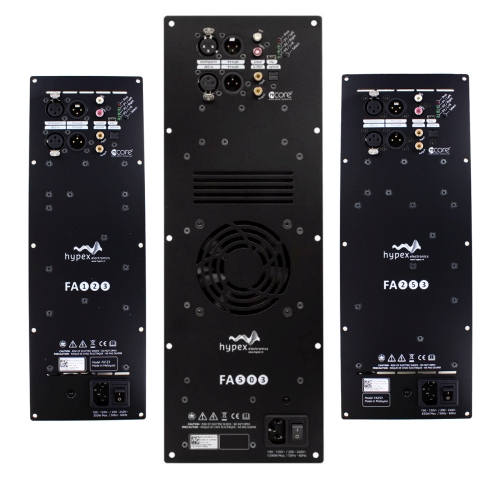DSP and PlateAmp
Why DSP ?
Active crossover with DSP is advised for horn speakers: The energy in the horn is defined at the begining and as we want a constant directivity behavior the on-axis horn response will show a bell shaped response, as explained here in Horn & Energie.
It would be very hard to do a passive crossover for a high efficiency horn speaker.
DSP PlateAmp : The Hypex Fusion Amp
The Hypex Fusion Amp line-up are state of the art Class D + DSP :

They have FIR capacities, powered by the Hypex Ncore MP family.
They have all possible inputs including AES/EBU and even a remote control for sources and volume so they act also as a pre-amp.
A passthrough allows adding a sub.
Mini DSP Flex HTx
The Flex HTx, and not the “HT”, is a 8ch IN (USB/HDMI/Analog) or 2ch IN (Toslink/SPDIF) to 8 channels OUT asymmetrical and symmetrical analog.
Powered by a SHARC CPU, the best one.
The capacity to accept multicanal on HDMI E-ARC input is very rare for a DSP and routing capacities allow it to easily add a sub.

It need to be paired with amp, with symmetrical analog output.
Pro solution, the Xilica Solaro FR1
The FR1 is a DSP with extended card for almost everything except HMDI, he can be in network thanks to DANTE and manage until 64 channels.

It need to be paired with block or pro amp, with symmetrical analog output.
Do Speaker Cables Need to Be Twisted?
We twist conductors to reduce electromagnetic interference — in practice, this helps cancel out the magnetic fields generated by the opposing currents. This is especially useful for low-level signals, like those coming out of a DAC, where even small EMI from the environment can degrade audio quality.
With amplified signals, such as those going to speakers, it’s a different story: the voltage and current are much higher, so the signal is far less sensitive to external interference. In that case, twisting the wires is mainly about reducing what they emit — to avoid polluting nearby low-level cables (RCA, microphones, etc.) with electromagnetic noise.
But if the speaker cables are short and there’s nothing sensitive nearby — typically the case inside a speaker enclosure — the benefit is negligible or even nonexistent. In such situations, twisting simply doesn’t matter.
That said, especially in subwoofer builds, you should still make sure the cables aren’t loose inside the enclosure. Strong vibrations can cause wires to flap against the driver basket or diaphragm, which can lead to buzzing or rattling noises — completely unrelated to EMI, but just as annoying. Tie them down or route them away from moving parts.